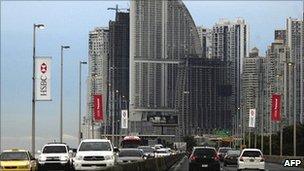UN sees Latin America growth but price bubbles 'a risk'
- Published

Panama's building boom is a visible sign of its economic growth
Economic growth in Latin America and the Caribbean is set to be 4.7% this year, the UN's regional economic body, ECLAC, says.
The growth is being fuelled by strong domestic demand with more people in work and able to access credit.
But ECLAC warns that the region faces the risk of worsening inflation, and capital inflows could produce bubbles in financial and property markets.
The fastest-growing economy will Panama on 8.5%.
The Economic Commission for Latin America and the Caribbean (ECLAC) , externalforecasts that overall growth will be 4.7% for 2011.
That represents a rise of 3.6% in per capita GDP.
Countries set to see strong growth include Argentina on 8.3%, and Peru on 7.1%.
ECLAC forecasts that the two biggest economies, Brazil and Mexico, will grow by 4%.
The report points to good news about jobs and in reducing poverty.
Growth is being sustained largely by people being in a position to buy and consume more, while investment is on the rise.
The overall unemployment rate is expected to come down again in 2011, to between 6.7% and 7%.
ECLAC says the formal economy is becoming a bigger part of the employment market in several countries, indicating that the new jobs being created are of better quality.
Continued economic growth and jobs rising in both numbers and quality should help bring fresh gains in poverty reduction, the report says.
Money in, money out
But ECLAC highlights some risks.
The region could become more vulnerable to speculative capital movements that may create bubbles in financial and real estate markets.
In addition, "that capital can leave from one moment to the next, severely disrupting growth," the report says.
The region is facing inflationary pressure amid rising food and fuel prices, but interest rate rises to tackle this have led to currency appreciation.
Strong currencies could pose a problem by undermining the competitiveness of exports.
"The region's economic authorities should implement measures to contain currency appreciation," ECLAC says.
These measures should combine intervention in foreign exchange markets, checks on the inflow of money and financial regulation.
- Published5 May 2011
- Published28 June 2011
- Published26 May 2011
- Published28 June 2011
- Published11 July 2011
- Published9 February 2011
- Published10 January 2011